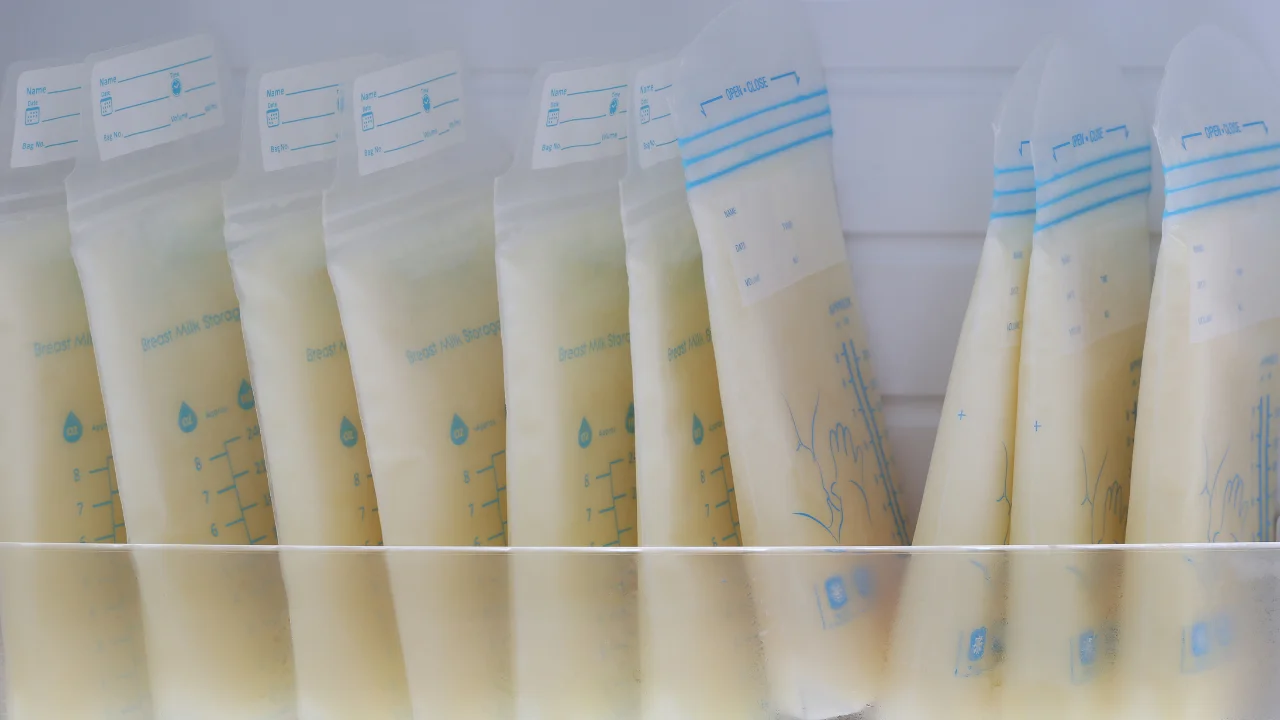
For safe breast milk storage, always handle milk under very clean conditions and follow the guidelines for storage times. You can use “the rule of 4” to remember how long pumped breast milk storage stays good: 4 hours at room temperature and 4 days in the refrigerator. You have a little more leeway with frozen milk – it’s best within 6 months but can last up to a year. If your baby starts a bottle and doesn’t finish it, use it or toss it within a couple of hours.
IN THIS ARTICLE
- How long can breast milk stay out?
- How long does breast milk last in the fridge?
- How to freeze breast milk
- How to defrost breast milk
- How long can breast milk be stored in a cooler?
- How to warm breast milk from the fridge
- How will I know if breast milk is bad?
- Breast milk storage chart
- Breast milk storage tips
Here’s a handy guide to storing and rewarming pumped breast milk safely before feeding it to your baby. We’ll tell you how long it’s safe to leave breast milk storage out on the counter, in the refrigerator, and in the freezer. (Maximum times and ideal times – for best quality – aren’t the same!) We’ll also provide tips for keeping your breast milk storage as fresh as possible.
Note that the guidelines below apply to healthy, full-term babies. If your baby is preterm, in the NICU, or ill, ask your baby’s doctor for individual guidelines.
How long can breast milk stay out?
It’s safest to use freshly pumped breast milk storage that’s sitting at room temperature (up to 77 degrees Fahrenheit) within 4 hours. If the milk is pumped under very clean conditions – and especially if the room temperature is on the cool side – it may be good for up to 6 to 8 hours.
If your baby starts a bottle of breast milk storage and doesn’t finish it, you have less time. During a feeding, bacteria enter the bottle from your baby’s mouth and will eventually spoil the milk. The problem is, there’s no way to tell exactly how fast that happens. Experts recommend giving your baby two hours to finish a bottle they’ve started. If they don’t, throw the milk out.
Try to keep bottles of breast milk storage out of direct sunlight. And if your baby often leaves bottles unfinished, prepare smaller quantities. It can be upsetting to throw breast milk storage away!
How long does breast milk last in the fridge?
Breast milk storage can be saved in the fridge (at a temperature of 39 degrees F or colder) for up to 8 days. This maximum is for ideal sanitary conditions, though, and it doesn’t mean the milk won’t deteriorate at all during that time. For the best quality (as far as nutrient content and immunity-boosting properties), use breast milk storage that’s in the refrigerator within 4 days.
Store breast milk storage in the back of the refrigerator, not on the door, where the temperature fluctuates when the door is opened and closed.
If you have more milk that you think your baby will drink in four days, freeze the extra.
How to freeze breast milk
Don’t fill the bottles or containers to the top; the milk needs room to expand as it freezes.
Though it can be stored in the freezer for 9 to 12 months, for the best quality use milk that’s been frozen within 6 months. Store milk in the back of the freezer, not on the door where the temperature isn’t steadily maintained.
Before stockpiling frozen milk, make sure your baby is willing to drink thawed milk. Sometimes thawed milk smells or tastes soapy when the enzyme lipase starts to break down the milk fats. The milk is still safe, though, and most babies will drink it.
How to defrost breast milk
To thaw frozen breast milk, hold the milk container under warm running water, or put it in a bowl of warm water. You can also thaw it by putting it in the fridge for about 12 hours. Thawed breast milk will keep in the fridge for 24 hours from the time it’s completely thawed (not from the time you took it out of the freezer).
Caution: Don’t thaw breast milk by leaving it out at room temperature, because that can allow harmful bacteria to grow. And never use a microwave to thaw frozen breast milk because it can create hot spots, which can burn your baby’s mouth. It also destroys some of the milk’s quality.
Remember to thaw and used the oldest milk first, because the quality of frozen breast milk can decrease over time.
Note: Don’t refreeze thawed breast milk because it may break down nutrients and increase the risk of bacterial growth.
How long can breast milk be stored in a cooler?
There may be times when you’ll need to bring breast milk along. If you’re traveling (or without a refrigerator or freezer – because of a power outage, for example), you can store breast milk in an insulated cooler for up to 24 hours.
Make sure the cooler is clean. Then place the containers of breast milk in direct contact with the ice packs. (You can buy a cooler with a contoured ice pack designed for this purpose.) When you arrive at your destination (or get your refrigerator cold again), use the milk right away or store it in the refrigerator or freezer.
How to warm breast milk from the fridge
Babies don’t need to have warmed milk, but some may prefer it. To warm chilled breast milk, leave the milk container sealed and hold it under warm running water, or put it in a bowl of warm water for a few minutes. If the milk has separated into layers, gently swirl it to recombine.
Test the temperature of the milk before feeding to your baby by putting a few drops on your wrist.
Caution: Never use a microwave to heat up breast milk because this can create hot spots, which can burn your baby’s mouth. Microwaving (and quickly heating on the stovetop) also destroys some of the milk’s quality.
How will I know if breast milk is bad?
Breast milk naturally separates into the fat layer on top and the rest on the bottom, and it’ll mix when you swirl it. But if the milk doesn’t mix well – it’s clumpy or stringy – it’s probably bad. It will also smell bad, much like cow’s milk that’s bad. And, like bad cow’s milk, breast milk that’s old will taste sour.
Always label your pumped milk with a time and date so you can tell how old it is. Breast milk starts to lose nutritional and immunological benefits over time, so use it in the order you stored it.
Toss milk that’s unused by the maximum period of time, and dump any that looks bad or smells sour, even if it’s not expired.
Breast milk storage chart
Here’s a handy chart of the specific numbers:
| Room temp: (77 degrees F or colder): | Best: within 4 hours | Max: 6 to 8 hours | If left over from a feeding, use within 2 hours. |
| Refrigerator (39 degrees F or colder): | Best: within 4 days | Max: 8 days | |
| Freezer (0 degrees F or colder): | Best: within 6 months | Max: 9 to 12 months | |
| Cooler or insulated bag | Up to 24 hours | ||
| Thawed | 1 to 2 hours at room temperature, up to 24 hours in the refrigerator |
Breast milk storage tips
Bacteria will eventually spoil breast milk, but there are ways to slow down this process:
- Limit the amount of bacteria that gets into the milk by keeping things very clean. Always wash your hands before pumping, and use clean pump parts and bottles.
- If you’re not using it right away, put breast milk in a refrigerator or freezer. Cold inhibits bacteria’s growth.
- Store breast milk in bottles made of glass or hard plastic with tight-fitting lids. Or use plastic bags made for storing breast milk. They’re not as durable, but you can double bag for extra protection. Don’t store milk in disposable bottle liners or plastic bags not made specifically for breast milk. Avoid plastic bottles with the recycle symbol #7 and the letters “PC” (for polycarbonate) printed on them. These may contain BPA.
- Store milk in small amounts, such as 2 to 4 ounces, or as much as your baby usually drinks in one feeding.
- Write the date the breast milk was expressed on each bottle or container. If the milk is going to a childcare provider, put your child’s name on it, too. Then use the oldest milk first when you take it out.
- It’s okay to combine milk that’s pumped on the same day, but don’t combine milk that was pumped on different days. Chill freshly pumped milk in the refrigerator before adding it to previously expressed milk. Adding warm milk to refrigerated or frozen milk will cause it to heat up or partially thaw.
Read more about


Add a Comment